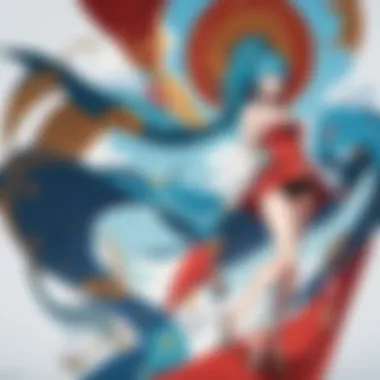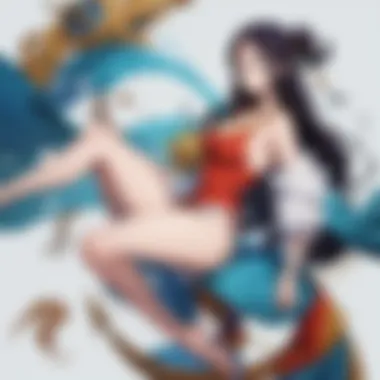A Deep Dive into One Piece Episode 1: A New Beginning


Intro
One Piece is not just an anime; it is an era-defining phenomenon that has reshaped the landscape of Japanese storytelling. Episode 1, which debuted in 1999, marks the beginning of a grand adventure that continues to resonate with audiences worldwide. This examination focuses on the nuances of this first episode, exploring how it lays the foundation for the saga that unfolds.
This analysis will evaluate the character introductions, narrative techniques, and thematic elements that are pivotal in that initial episode. We will discuss the cultural significance of One Piece and how its impact on anime can still be felt today. Understanding these aspects provides both dedicated fans and newcomers with a deeper insight into what makes this series a cornerstone of anime history.
Foreword to One Piece
One Piece stands as a monumental series in the realm of anime and manga. This section of the article lays the groundwork for understanding its profound significance. Introduction to One Piece serves as the portal to the exploration of its themes, characters, and artistic expressions. The aim is to provide insight into what makes this series resonate deeply with its audience.
Overview of the Series
One Piece, created by Eiichiro Oda, first premiered in 1997, both as a manga and subsequently as an anime in 1999. The narrative follows Monkey D. Luffy, a young boy with the ambition of becoming the Pirate King, as he sets out on an epic journey to find the fabled One Piece treasure. The series blends adventure, friendship, and the pursuit of dreams, sparkling a unique appeal that captivates a wide range of viewers. Luffy’s dynamic crew, known as the Straw Hat Pirates, each contribute their unique backstories and motivations to the overarching tale, enriching the narrative complexity.
Historical Context
The emergence of One Piece coincided with a transformative period in the anime industry. The late 1990s saw a surge in the popularity of shonen anime, targeting young male audiences with action-packed storylines. One Piece not only entered this landscape but transcended it through its unparalleled storytelling and character development. It was a time when many stories revolved around themes of heroism and adventure, setting the stage for One Piece to stand out. With its initial airing, it became one of the longest-running anime series, highlighting the ability to evolve while retaining core themes over the decades.
Cultural Impact of One Piece
One Piece has profoundly affected both the global anime culture and the entertainment industry. It has amassed a dedicated fanbase, resulting in extensive merchandise, films, and even video games that expand its universe. The series introduces complex moral dilemmas and social issues, allowing viewers to engage on deeper levels than simple entertainment. Its themes of camaraderie, loyalty, and the importance of dreams resonate widely, inviting scholars and fans alike to analyze its cultural dimensions.
In 2021, One Piece celebrated its 1000th episode, marking a significant milestone that underscores its long-lasting appeal and impact on the anime industry.
This exploration of Introduction to One Piece establishes the bedrock for understanding the series as a cultural touchstone. In the following sections, we will delve deeper into the intricacies of Episode 1, examining how it sets the stage for the epic journey that unfolds.
Episode Synopsis
The episode synopsis serves as a crucial component of this article, providing readers with a concise overview of the inaugural episode of One Piece. Understanding the episode's plot and key events helps to set the foundation for analyzing character development and thematic elements. By breaking down the narrative in this way, readers can grasp the significance of individual moments that contribute to the larger story arc. This section assists both newcomers and seasoned fans in navigating the rich tapestry of the series, highlighting essential plot points.
Plot Summary of Episode
In the first episode of One Piece, viewers are introduced to Monkey D. Luffy, a young boy with aspirations of becoming the Pirate King. The episode opens with a flashback that reveals Luffy’s inspiration, the infamous pirate Gol D. Roger, whose last words sparked the Great Pirate Era. Luffy sets sail from his home village with a straw hat given to him by Shanks, a charismatic pirate who once visited his hometown.
Luffy’s journey begins in a small canoe as he quickly learns the challenges of the sea. During his voyage, he encounters a group of pirates led by the violent Captain Alvida, who initially captures him. However, Luffy’s extraordinary rubber-like abilities allow him to escape and turn the tables on Alvida, showcasing his resilience and determination. This episode effectively establishes Luffy’s character as brave and somewhat reckless, traits that will be pivotal throughout the series.
Key Events and Their Importance
Several key events in this episode set the tone for the series and reveal the underlying themes.
- Luffy’s Encounter with Alvida: This confrontation not only serves as an introduction to Luffy’s abilities but also establishes his fearless nature. Luffy demonstrates that he will not easily back down from threats, a theme that recurs throughout the series.
- The Importance of the Straw Hat: The straw hat itself is a powerful symbol of Luffy’s dreams and connections, particularly to Shanks. It signifies Luffy's promise to become a great pirate and uphold his mentor's legacy.
- Introduction of the Pirate Era: The episode garners excitement by depicting the dawn of the Great Pirate Era, inviting viewers to contemplate the vast opportunities and challenges it presents.
These pivotal moments enrich the narrative and provide a clear foreshadowing of the relationships and conflicts to come. Each event works in tandem to illustrate the ambitions and fervor that drive the story forward, anchoring the viewer’s attention as they embark on Luffy’s adventure.
Character Preludes
Character introductions serve as the foundation of storytelling in anime and manga. They are crucial for establishing the personalities, motivations, and relationships of the key figures within the narrative. In One Piece Episode 1, these introductions not only lay the groundwork for character development but also engage the audience by providing a glimpse into the world of pirates and adventures.
Character introductions create a connection between the viewer and the characters. By understanding who they are, viewers become invested in their journeys, struggles, and triumphs. In the case of One Piece, the diverse cast contributes to a rich tapestry of interactions, making it essential for the audience to grasp these initial portrayals. Let's delve deeper into the main characters introduced in this episode.


Monkey D. Luffy: The Protagonist
Monkey D. Luffy stands out as a character of immense significance in Episode 1. His motivations and cheerful demeanor set a tone that resonates throughout the series. Luffy seeks the title of Pirate King, which translates into a broader quest for freedom and adventure. This aspiration encapsulates not only a personal goal but also a universal theme of seeking one's dreams.
Luffy's character design also plays a role in his introduction. His straw hat symbolizes his commitment to becoming a pirate and hints at his adventurous spirit. Moreover, his devil fruit ability, which allows him to stretch his body, hints at the unique capabilities that differentiate him from other protagonists in anime. This enables the audience to understand Luffy's potential and foreshadows the challenges he will face.
Foreword of Shanks
Shanks, while not the main character, is essential in shaping Luffy's journey. His introduction is both impactful and poignant. Shanks's laid-back attitude and charismatic nature contrast starkly with Luffy's unrefined exuberance. This dynamic offers viewers insight into various interpretations of what it means to be a pirate.
The relationship between Luffy and Shanks establishes key themes of mentorship and growth. Shanks's act of sacrificing his arm to save Luffy from the sea monster reinforces the weight of protective camaraderie. This moment not only signifies the depth of their bond but also serves as a catalyst for Luffy's determination to pursue his ambitions, thus shaping his character arc from the very beginning.
Supporting Characters Present in Episode
The supporting characters also contribute to the richness of Episode 1. Although they appear briefly, their roles are significant. For example, the members of Shanks's crew give insight into the pirate lifestyle and underscore the notion of friendship and loyalty.
- Buggy the Clown: A rival who highlights the competitive nature of pirates. His flamboyant personality offers comic relief while adding depth to Luffy's challenges.
- Mihawk: Known as the world's strongest swordsman, his brief appearance underscores the power dynamics in the pirate world, establishing stakes for Luffy's journey.
These characters, even if they do not dominate the scene, enhance the atmosphere and serve to enrich the narrative tapestry. Each introduction in this first episode is deliberate, ensuring that the future interactions within the series preserve consistency and depth.
Narrative Techniques
Narrative techniques are the backbone of any successful storytelling, serving as the method by which a tale is constructed and conveyed. In the context of the first episode of One Piece, these techniques play a crucial role in establishing the foundation for the series. They not only introduce characters and plot elements but also create an emotional connection with the audience.
Understanding these techniques enhances the viewer’s appreciation of the narrative depth and the foresight the creators have put into the series. It guides the audience through the unfolding story, setting the tone for the adventure that lies ahead.
Storytelling Methods Used
In Episode 1, multiple storytelling methods are employed to convey the narrative effectively. Some of these methods include:
- Direct Character Introductions: Each character's personality and purpose are swiftly communicated, especially Luffy’s carefree nature juxtaposed with Shanks’s formidable presence.
- Exposition Through Dialogue: Rather than relying heavily on narration, crucial backstory is revealed through dialogue. This method helps maintain a natural flow of information without feeling forced.
- Visual Storytelling: The animation itself tells large parts of the story. The vibrant colors and dynamic backgrounds enhance the emotional tone of certain scenes, especially during moments of tension or excitement.
These methods combined create a seamless transition from one event to another, laying down a rich narrative tapestry that invites viewers to engage with the material.
Foreshadowing and Its Examples
Foreshadowing is a significant narrative technique that hints at future events or outcomes, creating anticipation and depth in the story. In Episode 1 of One Piece, several instances of foreshadowing can be identified:
- Luffy’s Dream: Early in the episode, Luffy expresses his ambition to become the King of the Pirates. This declaration sets the stage for all his future adventures and conflicts. It also signifies that his journey will be fraught with challenges and growth.
- Shanks’s Sacrifice: When Shanks saves Luffy from a sea creature, it hints at his crucial role as a mentor and protector but also suggests that danger and sacrifice are recurring themes in the story. This moment builds credence to Luffy's desire to emulate Shanks while also indicating the potential losses he may face.
"Foreshadowing lays the groundwork for character development and plot progression in profound ways."
- The Appearance of the Pirate Flag: The sighting of the jolly roger foreshadows the imminent clash Luffy will face with other pirates. This detail subtly builds tension and prepares viewers for the inevitable challenges Luffy will encounter on his journey.
Artistic Elements
The artistic elements in One Piece are critical to understanding its identity and appeal. Early on, these elements not only contribute to the visual storytelling but also shape the overall experience for viewers. The vibrant animation style, character designs, and the use of colors all serve a purpose in immersing the audience in the world created by Eiichiro Oda.
Animation Style and Techniques


The animation style of One Piece is distinct and engaging. Its early episodes showcase a unique blend of exaggerated movements and expressive color palettes. The use of fluid animation during action sequences enhances the sense of adventure and excitement, capturing the viewer's attention. Specific techniques, such as dynamic camera angles and quick cuts, bring a sense of energy to the scenes.
Moreover, the artistic direction incorporates a mix of 2D animation with some 3D elements, which presents a more vivid experience compared to many contemporaries. The cartoonish art style may seem simplistic, but it conveys emotion effectively, which resonates with audiences.
In Episode 1, Luffy's enthusiastic introduction is highlighted by bursts of colorful animation. The playful representation of his rubber-like body adds a layer of charm. Such imaginative visuals create a memorable first impression.
Character Design Choices
Character design in One Piece is a crucial element that contributes to its charm and recognition. Each character has a unique and exaggerated look that reflects their personality and background. For instance, Monkey D. Luffy is designed with a simple yet memorable appearance: his straw hat, wide eyes, and carefree demeanor immediately establish him as a recognizable protagonist.
Shanks, whose laid-back attitude is captured in his sharp jawline and casual attire, is another excellent example. The design choices made for each character serve to enhance their narrative purpose. The colors used in their clothing often align with their personality traits or roles in the story. As the series progresses, these designs evolve but retain core elements that fans come to adore.
"Character designs play a critical role in One Piece, creating an immediate connection between audiences and the characters they encounter."
Successful character designs invite audiences to form emotional connections, and this initial episode sets the groundwork for future relationships between viewers and the extensive cast of characters.
In summary, the artistic elements in One Piece, particularly the animation style and character designs, are fundamental in establishing the series' identity. They lay the groundwork for the storytelling that continues beyond the first episode, thus captivating audiences from the get-go.
Themes and Motifs
The themes and motifs of One Piece are essential in understanding the foundational elements introduced in Episode 1. This episode does not merely set the stage for the series but also emphasizes core ideas that resonate throughout the narrative. This examination enables viewers to appreciate the intricate fabric of the story that unfolds.
Major Themes Introduced
The first episode of One Piece introduces several major themes that are pivotal to the overall narrative. Among these is the theme of friendship. This theme is encapsulated in the relationship between Monkey D. Luffy and Shanks. Luffy's admiration for Shanks illustrates how bonds can inspire courage and determination, a recurring motif in the series.
Another significant theme is the pursuit of dreams. Luffy's aspiration to become the Pirate King takes center stage, setting a precedent for character motivations in subsequent episodes. This theme resonates with viewers as it reflects universal desires for personal fulfillment.
The theme of adventure is also prominent, as indicated by Luffy's undertaking to join the ranks of pirates. This adventure symbolizes not just a physical journey but the exploration of one's character and limits.
Symbolism in Episode
Symbolism plays a crucial role in conveying deeper meanings in Episode 1. One potent symbol is the straw hat that Shanks gives to Luffy. This hat is not just an accessory; it represents Luffy's commitment to his dream and his connection to Shanks. The act of receiving the straw hat signifies trust and an oath, elements crucial to Luffy's character development.
Another symbol present is the sea, which represents freedom and the unknown. The ocean is an expansive realm filled with potential and peril, mirroring Luffy’s ambitions. The sea draws the viewer’s attention to the theme of exploration, both external and internal.
"The vastness of the ocean not only represents the journey ahead but also the infinite possibilities that come with pursuing one's dreams."
Overall, the themes and symbols introduced in Episode 1 lay a solid groundwork for understanding the narrative dynamics of One Piece. They serve not only as thematic anchors for the audience but also as motivators for character growth throughout the series.
Initial Reception and Impact
The initial reception of One Piece is a crucial aspect of its legacy. This moment sets the tone for the entire series, marking its entry into the anime world and shaping audience expectations. Understanding this reception involves examining viewership statistics and critics' responses, which together provide insight into how the series was perceived at launch.
Viewership Statistics
One Piece premiered on October 20, 1999, and immediately caught the attention of audiences. It maintained a strong viewership, especially among the target demographic of young adults and teenagers. In its first week, the episode attracted millions of viewers, illustrating a robust appetite for pirate-themed adventures. This strong start led to One Piece becoming a flagship series for Toei Animation.
Subsequent episodes further solidified its popularity. The numbers kept climbing, with a significant portion of its viewership staying engaged beyond the first episode. The sustained ratings over time indicated that the mix of adventure, comedy, and unique characters resonated well with audiences.


Critics’ Responses
The critical response to One Piece episode one was varied but generally positive. Reviewers praised the animation quality and character design, noting that they set a new standard for anime at the time. Particularly, Monkey D. Luffy’s introduction was seen as refreshing and relatable. Critics acknowledged that the first episode successfully established the whimsical tone that would become a hallmark of the series.
However, some critiques centered around pacing and storytelling methods. Certain reviewers felt that the episode was overloaded with information, which may have overwhelmed newcomers. Despite this, the general consensus was that the engaging characters and well-done animation compensated for any pacing issues.
"The strength of One Piece lies in its ability to blend humor with adventure, creating a world where viewers want to get lost in."
This varying response ultimately did not hinder the show's growth, as early criticisms were often overshadowed by its increasing popularity. The monumental viewership numbers and favorable critical reception helped solidify One Piece’s role as a game changer in the anime industry.
One Piece's Legacy
The legacy of One Piece is profound, extending far beyond its original episode. This series has cemented itself as a cornerstone in the anime landscape through its compelling narrative and dynamic characters. It has influenced countless subsequent anime, laying the groundwork for thematic and narrative structures that many have emulated or drawn inspiration from.
Influence on Future Anime
One Piece has had a considerable impact on future anime productions. The storytelling ability of Eiichiro Oda is evident in how he interweaves complex narratives and themes, creating a rich world that captivates viewers. Many series that followed drew from this successful formula.
For instance, shows like Fairy Tail and My Hero Academia have adopted similar themes of friendship and adventure, deeply influenced by the sense of camaraderie seen in Luffy's crew. Furthermore, the character development seen in One Piece is exemplary, encouraging new works to explore their characters in depth over extended episodes.
The concept of embarking on epic voyages to achieve dreams, integral to One Piece, has become a common motif in modern anime. As a result, One Piece set a new standard for shonen anime, elevating the expectations of both storytelling and character arcs in future works.
Longevity of the Series
The longevity of One Piece is another testament to its legacy. Since its debut, the series has continued to gain popularity, captivating multiple generations of audiences. As of now, the manga has been running for over two decades, and the anime has reached over a thousand episodes. Such endurance is rare in the industry.
Several factors contribute to this sustained interest:
- Dynamic Plot Lines: The continuous evolution of plots keeps viewers engaged, as unexpected twists and turns add layers to the storytelling.
- Character Development: The characters undergo significant growth, which resonates with the audience, making their journeys relatable.
- Expansive Universe: The vast world that One Piece inhabits allows for endless exploration and story potential.
As a multi-faceted and resilient franchise, One Piece maintains its relevance in a rapidly changing media landscape. This enduring legacy not only highlights the series' success but enriches the broader anime culture by providing inspiring storytelling templates.
"One Piece shows us the power of dreams and the importance of companionship. Its legacy is a reflection of the heartfelt stories that anime can tell."
The End
The conclusion of this article highlights its central themes and findings surrounding the first episode of One Piece. It serves as a crucial point that synthesizes the information presented, allowing readers to reflect on how the episode constructs a foundation for the entire series. Understanding the intricacies of the character introductions, narrative structure, and thematic elements laid out in this episode is essential for appreciating the long-term impact of One Piece on the anime industry.
One of the specific elements to consider is the way the episode encapsulates the essence of adventure and friendship, establishing these motifs as central tenets throughout the series. By depicting Monkey D. Luffy’s ambition to become the Pirate King and his early relationships, the episode primes viewers for the ensemble dynamics that will evolve.
Additionally, the analysis of the episode's artistic and narrative techniques illustrates the meticulous craftsmanship behind One Piece. This sets the tone for future episodes, enticing viewers with a blend of humor and action that characterizes the series.
Overall, the conclusion emphasizes that the first episode is not just a standalone piece, but rather a significant entry point into an expansive narrative that grows richer with each chapter.
Summary of Key Points
The summary captures the pivotal ideas discussed in this article:
- The effective introduction of One Piece and its foundational characters.
- The innovative storytelling methods used to engage viewers from the outset.
- The artistic choices that establish a unique visual style distinct to the series.
- The major themes such as adventure, camaraderie, and ambition, which resonate throughout the show.
- The immediate impact and reception of the episode that laid groundwork for One Piece’s endurance in anime culture.
Future Directions of Analysis
Looking ahead, future analyses of One Piece can focus on several promising aspects:
- Comparative Studies: Examine the differences in storytelling between One Piece and other long-running series like Naruto or Bleach. Understanding viewer engagement strategies can yield insights into why certain series maintain popularity.
- Character Development Over Time: A detailed exploration of how character arcs evolve in One Piece will provide a richer understanding of the narrative depth the series offers.
- Cultural Significance: Investigating how One Piece reflects Japanese culture and values can offer deeper appreciation for its themes and characters.
These directions not only enhance our comprehension of the series but also contribute to broader discussions in anime studies.





